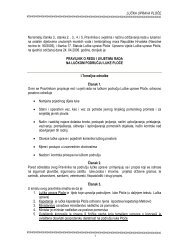HEADING PAGE - port of ploce authority * welcome
HEADING PAGE - port of ploce authority * welcome
HEADING PAGE - port of ploce authority * welcome
Create successful ePaper yourself
Turn your PDF publications into a flip-book with our unique Google optimized e-Paper software.
ENVIRONMENTAL IMPACT STUDY<br />
Rn: 03-033 CONTAINER TERMINAL PLOCE <strong>PAGE</strong>: 33<br />
13.9 m is recorded at the very end <strong>of</strong> the transect. In spite <strong>of</strong> a sunny day and<br />
relatively small depth, the visibility <strong>of</strong> the greatest part <strong>of</strong> transect was about<br />
0.5 m. Along last fifty meters, the visibility more or less equaled zero!<br />
Cross-section description (Fig. 35.):<br />
The beginning <strong>of</strong> transect PL-01 covers infra-littoral part <strong>of</strong> sandy mud to the<br />
depth <strong>of</strong> 1.4 m. By subsequent exploration <strong>of</strong> transect surroundings, it was<br />
recorded that the tidal movements zone almost does not exist, so that neither<br />
flora nor fauna species are recorded. In the infra-littoral part, at depth <strong>of</strong> 0.7<br />
and 1.0 m, a small “meadow” <strong>of</strong> Zoostera noltii sea grass is developed which<br />
is the only plant species recorded in the entire transect (Fig. 36.). With regard<br />
to animal species, numerous species <strong>of</strong> snails (Cerithium vulgatum i<br />
Nassarius sp.) as well as the hermit crabs (Paguridea indet.) in sub-fossil<br />
houses <strong>of</strong> these snails are registered. Numerous small holes in sediment most<br />
probably originated from the crabs Thalassinidea indet. but it was not possible<br />
to determine for sure by the used work method (Fig. 37.).<br />
Between the 14th and 30th meter <strong>of</strong> transect, the depth relatively suddenly<br />
increases from 1.4 to 7.9 m. Portion <strong>of</strong> sand decreases more and more in the<br />
sediment content, the bottom is almost naked, and judging by small hole<br />
density in sediment, the number <strong>of</strong> crabs in sediment decreases as well. The<br />
oases <strong>of</strong> hard base make some discarded cable in depth <strong>of</strong> 6.8 m, which is<br />
colonized by a thick community <strong>of</strong> filtering organisms. The most frequent<br />
organisms are white sea squirts (Styela plicata), marine fanworms (Sabella<br />
spalanzanii) and tube worms (Serpula vermicularis), and colonies <strong>of</strong> bryozoas<br />
(Schizobranchiella sanguinea) - (Fig. 38.).<br />
From the depth <strong>of</strong> 8.6 m, the bottom is naked and sediment consists <strong>of</strong> sticky<br />
terrigenous mud. The increase <strong>of</strong> depth is almost hardly noticeable, so that<br />
the greatest recorded depth is 13.9 m at the very end <strong>of</strong> transect. It should be<br />
emphasized that the visibility along the last 50 meters equalled zero, so that<br />
the absence <strong>of</strong> macro-organisms could not be determined with certainty.<br />
However, according to the description, terrigenous mud is the most frequent<br />
sediment (Fig. 39.).<br />
By this preliminary review, only 1 plant and 10 animal macrobenthic species<br />
have been recorded on the transect PL-01 area (Fig. A; Table I, II).<br />
Considering this more than modest number <strong>of</strong> species, it is hard to talk about<br />
the prominent bottom biocenosis. The finding <strong>of</strong> Zoostera noltii sea grass<br />
indicates the muddy sands biocenosis <strong>of</strong> protected coasts <strong>of</strong> the shallowest<br />
part <strong>of</strong> the transect. The remaining explored bottom part contains a very poor<br />
terrigenous mud community. Real population could be evaluated only by using<br />
a grab and by studying possible infauna sediments. Anyway, great<br />
sedimentation <strong>of</strong> the smallest fractions <strong>of</strong> suspended materials resulting from<br />
intensive river inflows is obvious. The only hard based enclave is <strong>of</strong><br />
antropogenic origin (discarded rope or cable) and is colonized by numerous<br />
sciaphilic filtering organisms (filtrators). Their density also indicates a strong<br />
and constant inflow <strong>of</strong> organic substances in suspension.<br />
Fish fauna has not been specially examined and only two species (dragonet<br />
Serranus hepatus and mullet -Mullus sp.) are recorded along the transect. Not<br />
a single species that would be interesting for fishing has been noticed.<br />
RIJEKAPROJEKT d.o.o.



